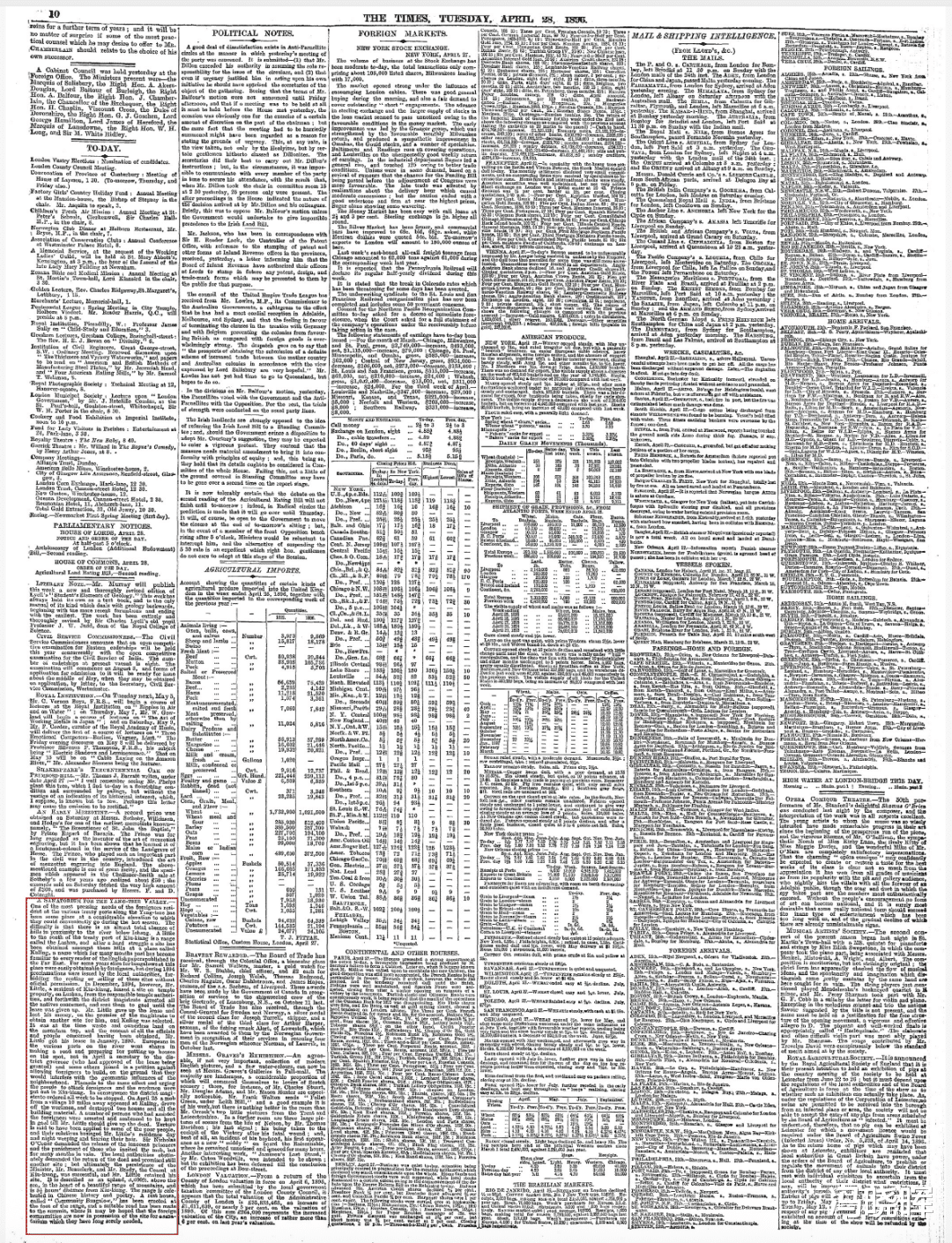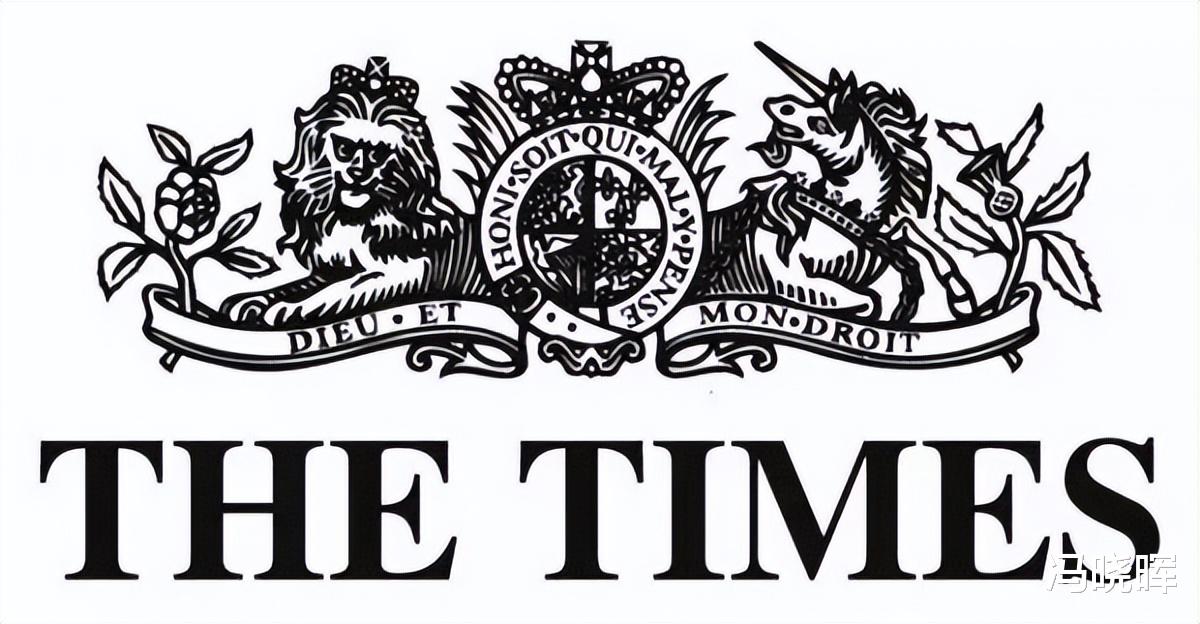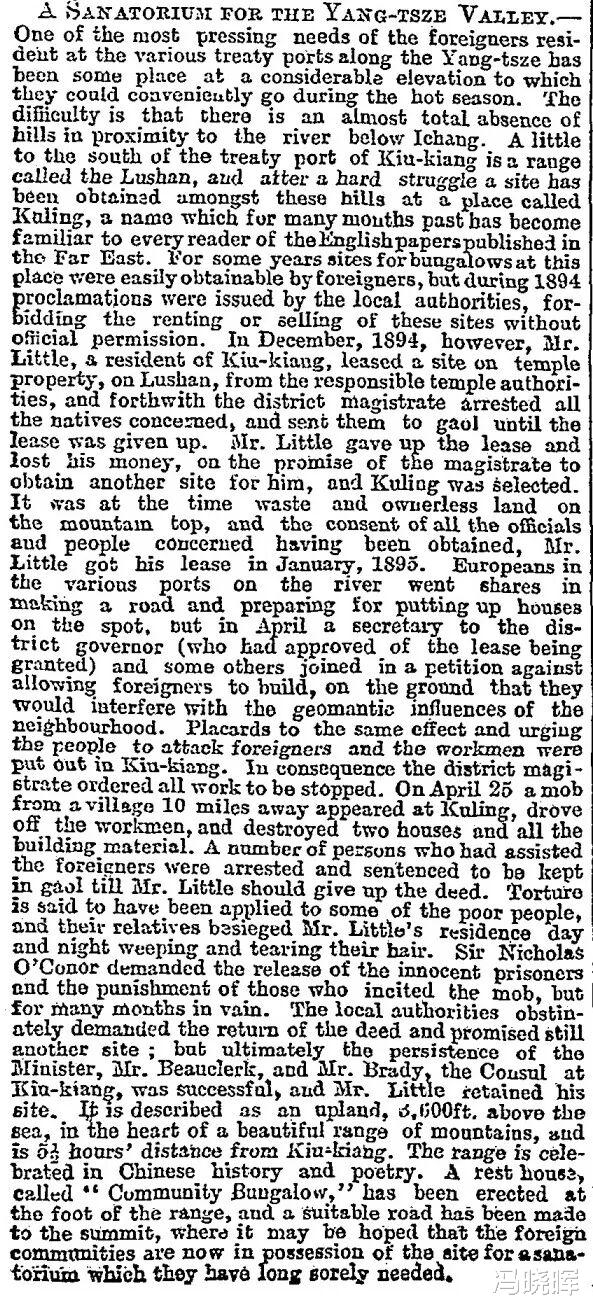译者:蚕豆 编撰:冯晓晖
“九江近代史料研究”系列作为“九江文史”下的子栏目,致力于深入挖掘早期报刊书籍、档案文件、历史照片、地图等原始史料,并结合当代视角加以解读,力求多维度展现九江近代历史的真实风貌。

一、史料来源与背景
【本篇资料】
来源:1896年4月28日,英国《泰晤士报》第10版。
标题:A SANATORIUM FOR THE YANG-TSZE VALLEY(扬子江流域的一处疗养地)。
作者:不详
【背景说明】
《泰晤士报》(The Times)创刊于1785年,是英国历史最悠久、影响力最大的全国性日报之一。长期以来被视为英国的“官方法定记录报”(newspaper of record),内容涵盖政治、国际事务、经济、文化与体育等多个领域,被誉为“英国社会的忠实记录者”。作为一份具有全球影响力的媒体,《泰晤士报》在世界政治、经济与文化领域均发挥着深远作用。

根据目前检索到的资料,这篇发表于1896年的文章,不仅是《泰晤士报》上首篇有关庐山的报道,也极有可能是欧美报刊中最早介绍牯岭避暑地的文字。
二、原文及译文
原文:

A SANATORIUM FOR THE YANG-TSZE VALLEY
One of the most pressing needs of the foreigners resident at the various treaty ports along the Yang-tsze has been some place at a considerable elevation to which they could conveniently go during the hot season. The difficulty is that there is an almost total absence of hills in proximity to the river below Ichang. A little to the south of the treaty port of Kiu-kiang is a range called the Lushan, and after a hard struggle a site has been obtained amongst these hills at a place called Kuling, a name which for many months past has become familiar to every reader of the English papers published in the Far East.
For some years sites for bungalows at this place were easily obtainable by foreigners, but during 1894 proclamations were issued by the local authorities, forbidding the renting or selling of these sites without official permission. In December, 1894, however, Mr. Little, a resident of Kiu-kiang, leased a site on temple property, on Lushan, from the responsible temple authorities, and forthwith the district magistrate arrested all the natives concerned, and sent them to gaol until the lease was given up. Mr. Little gave up the lease and lost his money, on the promise of the magistrate to obtain another site for him, and Kuling was selected. It was at the time waste and ownerless land on the mountain top, and the consent of all the officials and people concerned having been obtained, Mr. Little got his lease in January, 1895.
Europeans in the various ports on the river went shares in making a road and preparing for putting up houses on the spot, but in April a secretary to the district governor (who had approved of the lease being granted) and some others joined in a petition against allowing foreigners to build, on the ground that they would interfere with the geomantic influences of the neighbourhood. Placards to the same effect and urging the people to attack foreigners and the workmen were put out in Kiu-kiang. In consequence the district magistrate ordered all work to be stopped. On April 25 a mob from a village 10 miles away appeared at Kuling, drove off the workmen, and destroyed two houses and all the building material. A number of persons who had assisted the foreigners were arrested and sentenced to be kept in gaol till Mr. Little should give up the deed. Torture is said to have been applied to some of the poor people, and their relatives besieged Mr. Little's residence day and night weeping and tearing their hair.
Sir Nicholas O'Conor demanded the release of the innocent prisoners and the punishment of those who incited the mob, but for many months in vain. The local authorities obstinately demanded the return of the deed and promised still another site; but ultimately the persistence of the Minister, Mr. Beauclerk, and Mr. Brady, the Consul at Kiu-kiang, was successful, and Mr. Little retained his site. It is described as an upland, 6,600ft. above the sea, in the heart of a beautiful range of mountains, and is 5.5 hours' distance from Kin-kiang. The range is celebrated in Chinese history and poetry. A rest house, called "Community Bungalow," has been erected at the foot of the range, and a suitable road has been made to the summit, where it may be hoped that the foreign communities are now in possession of the site for a sanatorium which they have long sorely needed.
译文:
对于住在扬子江(Yang-tsze)沿岸各通商口岸的外国人来说,最急切的需求之一是在酷热季节能有海拔高度合适、方便再前往避暑的地方。困难在于,宜昌(Ichang)下游几乎完全找不到近岸的高处。
在九江(Kiu-kiang)的通商口岸以南不远处,有一片称为庐山(Lushan)的山脉。经过一番艰苦努力,终于在这片山间一个叫牯岭(Kuling)的地方拿到了一块地。过去的几个月,远东英文报纸的每位读者都已知晓了牯岭的名字。
多年以来,外国人都能轻易在此拿到土地,建造他们的小屋。但在1894年间,地方当局发布公告,禁止在未经官方许可的情况下擅自出租或出卖这些地皮。不过,当年12月,住在九江的利特尔先生(Mr. Little)*从庐山上值得信赖的寺庙负责人手中租下了一块属于寺庙财产的地皮。当地官府随即逮捕了所有涉事的中国人并将其送进监狱,直到租约被放弃。利特尔放弃了租约、损失了金钱,当地官府承诺为他另外找一处地方,牯岭就这样被选中了。当时,牯岭还是山顶的一片无主荒地。在征得所有相关的官员和老百姓同意后,利特尔于1895年1月签下了租约。
沿江各口岸的欧洲人分摊了在此修建一条道路和准备建造房屋的成本。但在4月,曾批准租约的地方长官的一位秘书却和其他人联名上书,抗议政府允许外国人在这块地皮上建造房屋,理由是他们会影响附近的风水。在九江,出现了同样担心风水受到影响并煽动攻击外国人和施工人员的标语。结果,当地官府下令停止所有工程。
4月25日,牯岭出现了一群来自10英里外村庄的暴民,他们赶走了工人,破坏了两栋房屋,毁掉了所有建筑材料。之后,很多曾经为外国人提供帮助的人士被逮捕,他们并被判处监禁——直到利特尔放弃租约方可释放。据说,在这些可怜的人里,有的遭到了酷刑,而他们的家属则包围了利特尔的住处,从早到晚嚎啕大哭、撕扯着自己的头发。
尼古拉斯·奥康纳爵士(Sir Nicholas O’ Conor)*要求释放无辜的犯人并惩处暴民的煽动者,然而数月未果。地方当局顽固地要求放弃租约,并再度承诺另寻一地。不过,驻清公使贝尔克勒先生(Mr. Beauclerk)*和驻九江领事布莱迪先生(Mr. Brady)*的坚持最终取得了成功,利特尔保住了他的地皮。
据称,这是一片海拔3600英尺的高地,位于秀丽群山的中心地带,距离九江5.5小时路程。此山在中国的历史和诗歌中颇负盛名。山脚修建了一间名为“公共小屋”的休息室,还有一条通向山顶的舒适小道。人们期待,外国社团如今终于在此拥有了一处渴望已久的疗养胜地。
三、注释与解读
* 利特尔先生(Mr. Little):即李德立(Edward Selby Little,1864—1939),英国传教士,牯岭避暑地的开发者(见编者所写的《九江历史上的今天 · 11月22日 · 冒险家李德立的传奇故事》)

李德立像 图源:hpcbristol.net
* 尼古拉斯·欧格纳爵士(Sir Nicholas O’ Conor, 1843-1908),英国外交官,时任英国驻清公使。另译作“奥康纳”“欧格讷”等。
* 威廉·贝尔克勒(William Nelthorpe Beauclerk, 1849-1908),英国外交官,曾在1892年、1895至 1896年间两次出任驻清公使临时代办。另译作“宝克乐。
* 赫伯特·布莱迪(Herbert Francis Brady,1854–1924),英国外交官,1876年进入英国驻华使团,历任九江、宜昌、上海等地领事职务,1906 年升任驻福州总领事 。布莱迪亦为热衷摄影与影像收藏的外交官,其摄影集《博览中华图志》收录大量十九世纪末中国城镇与风景影像,涵盖九江、宜昌及天津等地,为近代通商口岸研究的重要视觉史料。中文资料中偶作“雷夏伯”。
本篇文章介绍了李德立如何取得牯岭租借地的过程。其中的部分内容,在李德立所著的《Story of Kuling》(《牯岭的故事》)中有更详尽的记载,可参见编者所写《九江历史上的今天 · 11月29日 · 开辟牯岭,中国旅游地产的祖师级案例》一文。文中提到的寺庙,即今日马尾水景区内的九峰寺。
值得注意的是,文中所反映的英帝国主义者的傲慢心态,以及他们对中国官员与民众的轻蔑态度,在字里行间皆可见一斑。
【作者简介】
蚕豆,26岁,江西九江人,地方文化爱好者,博士在读。
【后记】本文的难得之处在于:这是目前所能检索到的最早一篇发表于英国的关于庐山避暑地的报道,也可视为一篇推广庐山牯岭地产的“软文”。
作者“蚕豆”是一位在北京攻读博士的九江人。因对家乡文化怀有浓厚兴趣,他查得此文后,将其译为中文并投稿于本公众号。能有这样的青年学者为九江文史研究添砖加瓦,实在是令人欣慰。